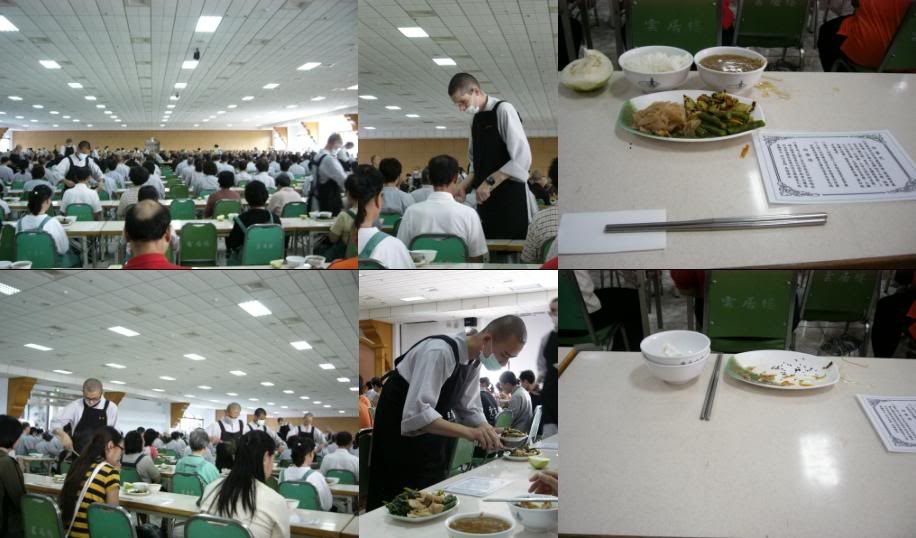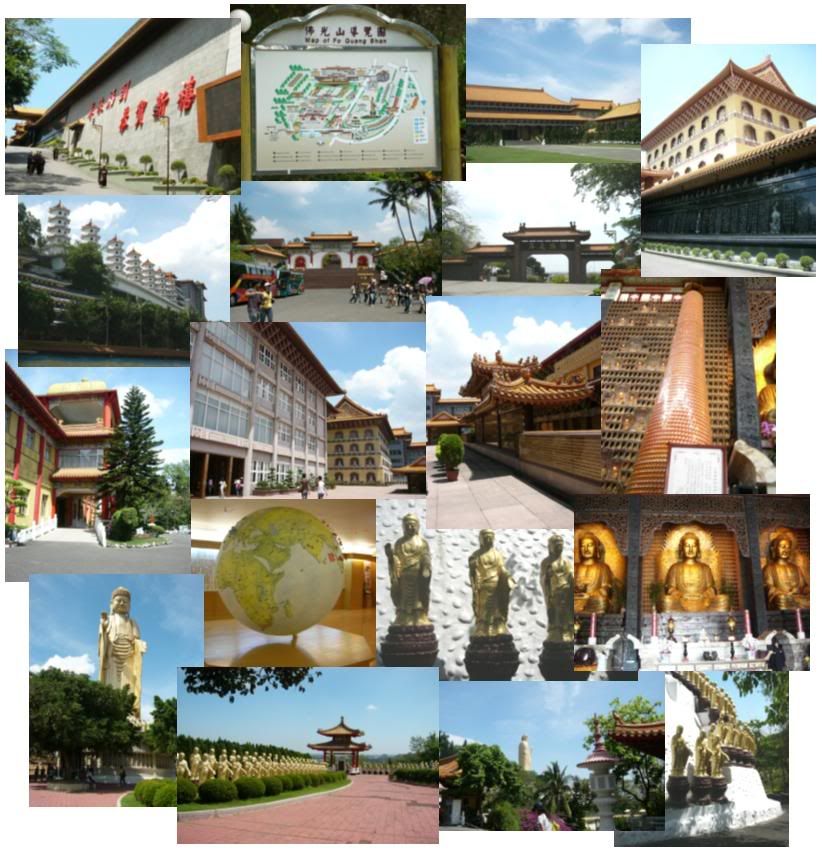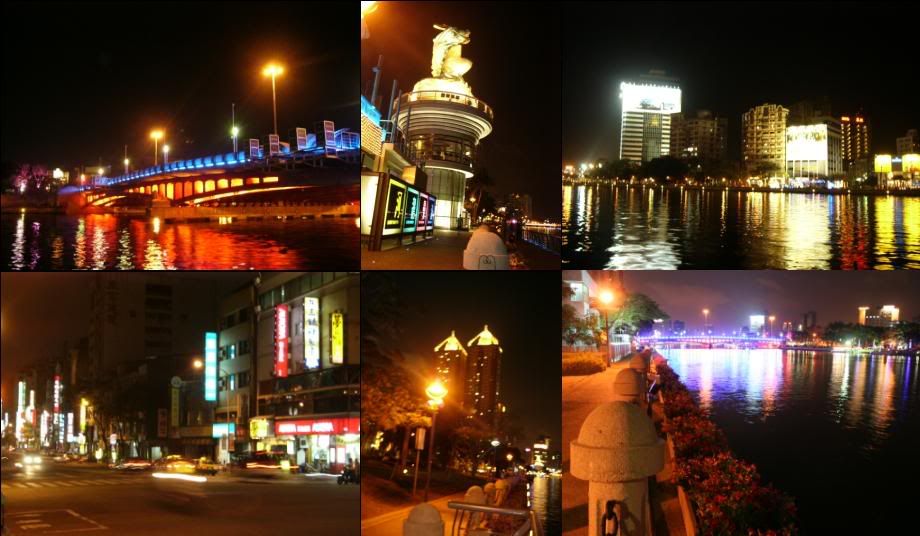Day 12 - Fo Guang Shan
Today’s Programme | |
| Morning | Fo Guang Shan |
| Afternoon | A trip of Xin Jue Jiang |
| Evening | Love River |
| Hotel | Toong Mao Hotel, KaoHsiung |
We had a long distance journey again as we had to go to the Fo Guang Shan Monastery which is famous and very large. The temple has been established in 1967. There’s even a Buddhist university there. We arrived at the temple very late, almost 11:30 am which is the lunch time there. We had to rush to the dining hall because we were going to have vegetarian meal there. It’s the food provided by the temple. We were told that the vegetarian food is delicious there. I was a little surprised when I arrived at the hall because there were about thousand of people, including the monks praying there. Half of the hall was full of monks and the venerables. Another half was full of normal people, like us. The tables there were arranged as a long line. There were already a dish containing string bean with a kind of vegetable and fried potato & pumpkin (There was space left on the dish for other food too), half piece of guava, and two empty bowls from far side of the table (see picture) for each of us. I sat and pressed my hands together at the chest trying to pray along with them. A couple of seconds later, a monk moved in front of my table line, starting from my right, poured rice onto a bowl, then another Caucasian monk came with a soup containing noodle, putting it onto another bowl. A minute later, another monk came with stirred vegetables, then another one giving boiled vegetable. He gave lots of vegetable onto people’s dishes. Everybody accepted without saying anything, but I saw that it’s the vegetable that I don’t really prefer, so I suddenly said “Wo yao xiao xiao” to tell him that I want only a little. No idea if it was correct Chinese, but he understood and only gave me a couple of pieces. It was funny that people on my left said the same thing. Hahaha at least I was the original. That’s all we got for the meal. We were told before arrival that we can tell them to take the food back (before we start eating) by moving the food we want close to our chest and leave the dish we don’t want to be away from us. I only wanted them to take guava ‘cos I am bored of it since I had it everyday at office. So, I moved all dishes close to my chest and left guava there. The monk came to collect it in a few minutes. I saw that other monk came to other people and used chopstick to take vegetables back too.

The monks there worked perfectly. While we were eating, there were monks providing services too. Some collected food, some distributed food. When we were full, we had to move the dishes away from us, and the monk came to collect the dishes very fast like a machine -_-‘
After lunch, each group got with a nun to have a tour around the monastery. There, we had to call the nun as “Shi Fu” or “Venereble” in English. The female venerable there can touch a male (but they shouldn’t) and the monk can also touch a female (they also shouldn’t do). The venerable of my group was very good in English ‘cos she was originally from Hong Kong.
The first place we visited was Main Shire. It was extremely big. There were 3 Buddha statues, 7.8 meters height each. The most right one that carried the ball was called “Bhaisajaguru Buddha (Medicine Buddha)”. The middle one was “Sakyamuni Buddha” of the Saha world. The most left was “Amitabha Buddha (Buddha of Infinite Light)” who was supposed to teach us the lesson after our death (before new born). On the left and the right of the shire, there were a drum and a bell. They were to be used on the important ceremonial days. Also, there were tiny Buddhas on the wall around the shire. The venerable told me that there are 14,800 Buddhas in total. There also are two pagodas consisting of tiny Buddhas, 7,200 in total. These pagodas imitate the one in Dun Huang, Urumuqi, main land China. There I also found out that the symbol that looks like the Nazi symbol but turned to another side is called “Sawaski” which is the symbol of Buddha and is originally from the queen Wu Jia Tian.

The venerable also showed us how to pay respect to the Buddha in Taiwanese style. It is different than the Thai way. In Taiwan, we had to start with standing and salute one time by pressing both hands on the chest along with bowing the head (like how to do “Wai” in Thai), then sit and lay both hands on the floor (like pushing the ground), then grape the hands (like being ready to fist) and turn them up a little bit before bowing the head for three times.
We then moved to the Meditation Hall which was little bit dark. We were told that it may consist of 400 people, but it was not very big. The venerable said it’s good to do meditation for about 30-45 minutes there and then quietly walk around. There was also a resting area behind the hall that provided tea and a bed room. We then moved to the museum that was very very beautiful but we were not allowed to take pictures. After talking to the venerable, she told me that there are Buddha classes in both Chinese and English there. There is even an university.
Due to time limitation, we couldn’t visit many places. So, we rushed to the symbol of the place, The Great Buddha land. The Great Buddha was located at the front part of the monastery with 36 meters in height, and is the highest standing Buddha in East Asia. There were 500 Buddha’s around the base of the Great Buddha. All of 500 Buddha looked the same — showing the right hand like doing bye-bye, and left arm down to the front. The venerable said that the right hand means “fearless” and the left hand means “welcome”.
From the temple, we headed to KaoHsiung, a city of factories. We were brought to a shopping area called “Chen Shi Guang Lan”. When I was on the road, I felt like I was home as there were lots of trucks in both places. This shopping area was boring, nothing interesting. The shopping area in ChungLi (Day 2) was much better.

The funny thing for me was that the Taiwanese people queue up to buy a kind of donut called Pon De Ring like the Thai queue up for Roti Boy. This was funny because Pon De Ring is not that famous in Thailand.
In the evening after having dinner at the hotel, they suggested us to walk to the “Ai He” or “Love river” in English. It wasn’t that beautiful, but not bad either. The nice scenario was from the neon lights along the river and the bridges. I think that at night the Chao Praya river in Bangkok is more beautiful.

After walking around, I finally realized that the name “Love river” must be a short name of ‘About-to-make-love’ as there were lots of couples along the river doing … hehehe



0 Comments:
Post a Comment
<< Home